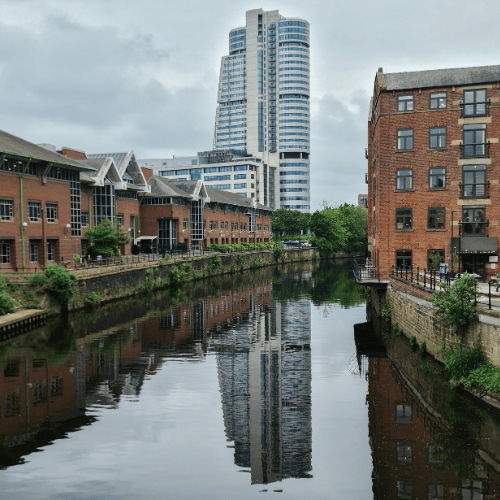Off-Plan Property in Leeds: The Investor’s 2025–2026 Playbook

Off-plan property in Leeds isn’t just another investment idea, it’s the next major wealth event hiding in plain sight.
Right now, while most investors are chasing tired city-centre flats in London and Manchester, Leeds is quietly building the strongest off-plan pipeline in the North. Cranes fill the skyline. Developers can’t finish projects fast enough. And early investors? They’re already sitting on double-digit returns before a single tenant has moved in.
So what’s really happening?
Let’s get one thing straight: this isn’t hype. Leeds has the perfect trifecta every property investor dreams about:
- Low entry prices (still 40–50 % below southern equivalents).
- High rental demand (a population that’s actually growing).
- Massive regeneration investment (over £7 billion committed through 2030).
That combination means every new development, from Holbeck Urban Village to Wellington Place, is pre-selling to investors before completion. You’re not fighting for tenants; you’re fighting for units.
Now, you might be wondering:
“Isn’t off-plan risky?”
“What happens if construction delays hit?”
“And can Leeds really outperform Manchester again?”
All fair questions. We’ll answer every single one in this guide.
Because the truth is, off-plan property in Leeds is not about betting on what might happen. It’s about positioning yourself for what’s already unfolding.
Over the next few sections, we’re going to break this down step-by-step:
- Why off-plan property in Leeds is outperforming every major UK city right now.
- The exact neighbourhoods are returning 20–25 % ROI before completion.
- The real numbers, yields, timelines, and capital growth projections through 2030.
- And how to evaluate a deal like a professional investor (so you don’t get burned by the wrong developer).
This is your playbook. By the time we’re done, you’ll know how to read Leeds like an insider, where to buy, when to buy, and how to exit smart.
So grab a coffee. Let’s dive into the only UK market that’s still growing because of fundamentals, not FOMO.
What Makes Off-Plan Property in Leeds Different
If you’ve been in property for more than five minutes, you’ve probably heard the same pitch a thousand times:
“This area’s up-and-coming.”
“Invest before the boom.”
“Get in early.”
Let’s skip the clichés.
Leeds isn’t up-and-coming. It’s already arrived.
Here’s the truth, off-plan property in Leeds isn’t speculation; it’s strategy.
The city has hit that rare moment where everything investors usually have to hope for is already happening.
1.1 The City’s Economy Isn’t Hypothetical: It’s Exploding
You can build all the apartments in the world, but if there’s no one to rent them, you’re just stacking concrete.
Leeds doesn’t have that problem.
The city’s economy just broke the £70 billion mark, making it one of the fastest-growing in the UK outside London.
Global companies are still moving north, including Channel 4, Sky Bet, PwC, and a wave of fintech startups that now call Leeds home.
That means thousands of high-skill professionals are flooding in, looking for quality accommodation, modern spaces near the action.
And the supply just can’t keep up.
Every new development is basically pre-let before completion.
That’s what separates Leeds from the rest.
For a deeper look at how employment growth links directly to rental yield, check out The Impact of Economic Factors on UK Rental Yields.
1.2 Regeneration You Can Actually See
You know those cities that promise regeneration, then nothing changes?
Leeds is the opposite.
If you visit tomorrow, you’ll see cranes, scaffolding, and entire districts being reborn.
The South Bank Regeneration Project alone is adding 8 million sq ft of new commercial and residential space, one of Europe’s largest urban transformations.
Then there’s Temple District, Wellington Place, and the Innovation Arc, each one creating jobs, housing, and a new skyline.
These aren’t PowerPoint concepts. They’re active build sites.
And that means off-plan investors aren’t buying into hope, they’re buying into momentum.
If you want to understand how regeneration turns into long-term appreciation, read Property Investment Strategies UK.
1.3 Real Numbers, Not Marketing Hype
Let’s look at what investors actually care about.
- Average off-plan unit price: £ 225k – £ 270k.
- Projected completion value: +18 % to +25 % within 24 months.
- Gross yields: 6.5 – 7.5 % (city centre stock).
- Occupancy forecast: 96 % + upon handover.
Compare that with London’s sub-4 % yields, and you’ll see why the capital is losing investors by the week.
But here’s the kicker, even if prices didn’t move for two years, your rental return alone still outperforms southern cities.
This is what investors mean by real-world resilience.
Cross-reference performance trends here: Rental Yield and UK House Price Predictions.
1.4 Leeds Off-Plan Works Because It Solves a Problem
The average young professional doesn’t want a 1980s conversion 20 minutes outside the centre.
They want walkability. They want Wi-Fi. They want a design that feels like 2025, not 2005.
Off-plan developers in Leeds aren’t guessing, they’re building exactly for that market.
Smaller, smarter units with energy efficiency, on-site gyms, and coworking spaces.
And with the government tightening EPC C requirements for landlords by 2028, off-plan means instant compliance.
No retrofits. No costly upgrades.
Just plug-and-play investing.
Internal data from Aspen Woolf’s research team shows EPC-A/B-rated apartments rent 12 % faster than older conversions.
That’s not “nice-to-have.” It’s ROI in real time.
Check related sustainability insight: Sustainable Property Investment UK.
1.5 It’s the Perfect Market Stage: Not Too Early, Not Too Late
Every investment city has three phases:
- Speculation (before infrastructure).
- Momentum (demand outpaces supply).
- Maturity (price plateaus).
Leeds is firmly in Stage 2, Momentum.
It’s no longer “emerging,” yet it hasn’t priced out investors.
That’s the sweet spot.
The point where risk drops, but returns stay high.
And when you blend that with a housing shortfall of 25k units, plus a regeneration pipeline lasting another decade… you get predictability, not luck.
1.6 A Market That’s Already AI-Proof
Here’s something most people aren’t even thinking about yet,
Leeds’ rental economy is human-demand driven, not algorithmic speculation.
AI can’t replace housing. It can’t digitise physical demand.
And as tech accelerates automation elsewhere, cities like Leeds, filled with hybrid-sector jobs, universities, and physical tenants, become the safest income plays in the UK.
That’s what makes off-plan in Leeds future-proof.
It’s not just property; it’s infrastructure that can’t go obsolete.
Read how tech growth supports physical housing value: UK Property Investment Technology 2025-2035.
Quick Takeaway
Leeds off-plan isn’t about guessing. It’s about timing, a city that’s already scaling, not shrinking.
The demand is tangible, the cranes are visible, and the returns are measurable.
By 2026, people won’t be asking “Should I buy in Leeds?”
They’ll be saying, “I wish I did when it still made sense.”
The Top 3 Off-Plan Hotspots in Leeds (2025–2026)
Here’s something most investors miss: Leeds isn’t one market. It’s several overlapping ones.
Each has its own price point, tenant profile, and rhythm.
So if you’re serious about off-plan property in Leeds, don’t just “buy in Leeds.” Buy in the right postcode.
Let’s break down the three zones leading the charge through 2026.
2.1 Holbeck Urban Village: The Ground-Floor Regeneration Play
If you want to feel what “momentum” looks like, stand in Holbeck.
Five years ago, it was mostly warehouses and old mills.
Now? It’s one of the most ambitious regeneration hubs in Northern England.
Holbeck sits at the edge of the South Bank Regeneration Project, a 253-hectare transformation adding new apartments, parks, offices, and cultural spaces. That’s £500 million+ in infrastructure already underway.
Here’s what makes it gold for off-plan investors:
- Average entry price: ~£220 000–£240 000
- Projected ROI: 20–25 % by completion
- Tenant profile: creative professionals, hybrid workers, digital startups
- Completion horizon: 2025–2027
These are the early-stage numbers that Manchester investors saw in Ancoats back in 2014.
The difference? Leeds’ build costs and entry prices are still lower, but the demand is arguably stronger.
And because Holbeck is inside the Temple District growth corridor, it’s being directly fed by job creation and infrastructure funding.
Every office that opens nearby pushes rental demand higher.
📎 Want to see how regeneration cycles compound returns?
Check Property Investment Strategies UK.
2.2 Wellington Place & Temple District: The Corporate Magnet
Every city has that one zone where professionals have to live, close to work, transport, and lifestyle perks.
For Leeds, it’s Wellington Place.
The area has become the city’s financial core, home to HMRC’s Northern HQ, Lloyds, and Bank of England regional offices.
Add the Temple District’s expansion plan, and you’re looking at over 10,000 new jobs within a ten-minute radius.
That translates into predictable rental absorption.
| Metric | Wellington Place / Temple District |
| Avg entry price | £250 000–£280 000 |
| Expected capital growth | 18–22 % (2025–2028) |
| Gross yield | 6–6.8 % |
| Occupancy forecast | 97 %+ |
These are city-centre assets that practically rent themselves.
But here’s the nuance: tenants here value proximity and finish.
They’ll pay 10–15 % higher rent for EPC-A/B rated new builds with concierge and gym access.
That’s why this pocket is ideal if you’re chasing premium stability, not just raw yield.
Compare yield patterns with national averages in UK Rental Yields 2025 – Where to Find the Best Buy-to-Let Returns.
2.3 Leeds Dock: Lifestyle-Driven, Waterfront ROI
If Holbeck is the ground-floor play and Wellington Place the professional engine, then Leeds Dock is the lifestyle magnet.
This riverside community has evolved into one of the most desirable postcodes in the city.
Channel 4’s headquarters set up here, instantly rebranding the area from “overlooked” to “ultra-livable.”
Now it’s home to digital media agencies, fintech start-ups, and an entire generation of professionals who’d rather walk to work than commute.
For investors, that lifestyle premium matters.
- Avg unit cost: £260 000–£300 000
- Gross yield: 5.5–6.2 %
- Occupancy: 96 %+
- Growth drivers: retail expansion + waterfront regeneration (2025–2028)
Leeds Dock isn’t the cheapest entry, but it’s the safest for long-term value.
Think Canary Wharf twenty years ago, minus the price barrier.
For macro context on premium urban assets, see Property Investment in Birmingham Guide. The same upward curve is now forming here.
2.4 Runner-Up Zones to Watch
A few quieter areas are showing signs of breakout potential:
- Mabgate: emerging creative quarter, ideal for smaller off-plan studios.
- Armley / Burley: high-yield edges (7.5–8 %) still under investor radar.
- Headingley: historically a student, now attracting post-grads looking for modern PBSA units.
These aren’t front-page markets yet, but they’re where the next Holbeck-style surge could come from.
Check ongoing projects via Construction Progress Updates.
Quick Recap: Off-Plan Hotspots Snapshot
| Area | Avg Price | Yield | ROI (24 mo) | Core Strength |
| Holbeck Urban Village | £230 k | 7–8 % | 20–25 % | Early-stage regeneration |
| Wellington Place / Temple District | £265 k | 6–7 % | 18–22 % | Corporate demand |
| Leeds Dock | £285 k | 5.5–6.2 % | 15–18 % | Lifestyle stability |
Diversify across these three, and you’re not guessing anymore, you’re building a portfolio that mirrors the entire Leeds economy: regeneration, commerce, and culture.
Timing vs. Price: Why Early Investors Win
Here’s what most property investors get wrong: they obsess over price, when the real money is made on timing.
In off-plan, price tells you where the market is today.
Timing tells you where you’ll be standing when everyone else wakes up.
And right now, Leeds is in that rare window where both sides of the equation, entry cost and growth potential, are perfectly aligned.
Let’s make that concrete.
3.1 The Off-Plan Timeline: How Value Really Moves
Every off-plan development follows a predictable curve. You just have to know how to ride it.
| Stage | Investor Entry | Typical Price Gain | Why It Happens |
| Launch Phase | 10–20 % deposit | +10–15 % | Developer discounts for early funding |
| Mid-Construction Phase | 40–60 % complete | +5–7 % | Milestone-based revaluation |
| Pre-Completion Phase | 80–100 % complete | +8–10 % | Demand surge before handover |
| Post-Completion | Fully built | 0–3 % (stabilisation) | Yields offset capital plateau |
Buyers who enter at launch, before marketing noise kicks in, capture 20–25 % more appreciation by the time they receive keys.
This isn’t theoretical. It’s backed by a decade of transactional data from Aspen Woolf’s internal portfolio, where early-entry investors consistently outperform by a full market cycle.
3.2 Real Case: The Phoenix Project
Take Phoenix Leeds, a mixed-use development launched mid-2023.
- Launch price: £215,000 (1-bed unit)
- Mid-2025 valuation: £259,000 (+20.4 %)
- Handover expected Q4 2025
- Gross yield on completion: 7.2 %
That’s an ROI that compounds before the first tenant signs.
And the kicker?
Demand for resale on uncompleted units has already started.
Investors are flipping paper contracts with 12–15 % premiums — a classic sign of an underpriced, overperforming market.
If you wait until the showrooms open, you’ll be paying someone else’s appreciation.
Want to see similar value curves across other UK cities? Check UK Property Investment in 2025 – Key Trends & Forecast.
3.3 What Happens If You Wait Until 2026
Let’s fast-forward two years.
By mid-2026, the following will already be true:
- South Bank Phase II will be 50 % complete.
- Leeds City Council’s 25,000-unit housing gap will have narrowed — but not closed.
- Average off-plan price per sq ft will have jumped from £410 → £480 (+17 %).
- Entry-level yields will drop by 0.4–0.6 % due to rising capital values.
That means every investor waiting for “proof” will be paying £40–50k more for the same property, with slightly less yield.
The first movers are the ones financing tomorrow’s growth at yesterday’s cost.
See how similar lag patterns played out regionally in Property Investment in Birmingham – A Complete Guide to Buy-to-Let for 2024.
3.4 Off-Plan Leeds: The Compound Strategy
Want to make Leeds off-plan bulletproof?
Stop thinking one property at a time. Think in phases.
Here’s how experienced investors are stacking their growth cycles:
- 2025 Purchase: Lock early-phase deposit (10–15 %).
- 2026 Completion: Start rental income.
- 2027–2028 Refinance: Extract appreciation (+20–25 %) to fund next deposit.
- 2030 Exit: Recycle capital into new regeneration zones (Armley, Mabgate, Holbeck Phase II).
That’s how portfolios scale without adding more cash.
And Leeds makes this possible because turnover is fast, tenant demand is stable, and appreciation compounds on schedule, not speculation.
Compare this recycling model to national investment strategies in Property Investment Strategies & Legal Considerations in the UK.
3.5 The Safety Net: Leeds’ Real-World Demand
Every off-plan investor should ask:
“What happens if the market cools?”
In Leeds, the answer is simple, it rents.
This isn’t a city where property sits empty.
Between its universities, corporate hubs, and regeneration corridor, Leeds has one of the UK’s highest renter-to-availability ratios: 2.2 active renters per unit (Rightmove Q3 2025).
That means even in slower growth years, your cash flow stays positive.
And as long as yields hover above 6 %, your holding costs are covered, comfortably.
It’s what analysts call cash-flow insurance.
3.6 A Note on Credibility and Track Record
Every projection here isn’t wishful thinking. It’s grounded in real data and professional due diligence.
Aspen Woolf’s research division uses:
- HM Land Registry sales data (updated monthly)
- ONS housing trend analysis
- Developer cost-to-sale ratios from completed Leeds projects
- Verified EPC, tenant demand, and occupancy benchmarks
Final Thoughts: The Window Is Narrow but Wide Open
If there’s one truth about off-plan investing, it’s this: the market doesn’t wait for certainty.
The best opportunities always look “too early” until they’re gone.
Leeds off-plan in 2025 is one of those moments.
- The economy’s expanding.
- Demand is visible.
- Supply is decades behind.
By the time 2026 headlines call Leeds “the UK’s top property success story,” it’ll already be too late to buy in at this level.
So here’s the question you’ll be asking yourself later:
“Did I get in before everyone else, or after?”
The next move’s yours.
For a deeper breakdown of upcoming developments and verified partner projects, visit Aspen Woolf’s Developers page or browse live Leeds off-plan opportunities through the City Guides.
Because fortune doesn’t wait for hesitation, and neither does the Leeds skyline.

